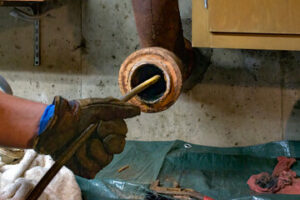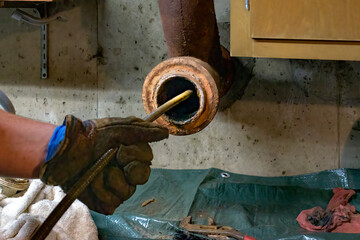Clogged drains are a nuisance and a major inconvenience. Drain Cleaning Sarasota can prevent clogs and keep your home plumbing functioning properly.
Store-bought liquid drain cleaners contain corrosive chemicals that can damage your drain and pipe walls. Plus, they often don’t clear residue and other buildup.
Fortunately, there are safe and effective alternatives to chemical drain cleaners.
Hydro jetting is the most accurate and precise way to unblock your drain pipes. It removes the most stubborn clogs and cleans away residue completely, so there is no chance for future blockages to form. It is also environmentally friendly because it does not put any chemicals into your sewer system or wastewater line. A plumber will feed a hose-like device with a nozzle into your clogged drain. The nozzle is made to direct the spray ahead and behind the hose for fuller coverage, so the clog will be broken up and flushed out of your pipe. The plumber will then use a video inspection to check that the clog is completely removed and the pipe is thoroughly cleaned.
Most clogs are caused by mineral deposits and sludge buildup that build up on the inside surface of your pipes over time. These can cause the walls of your pipe to deteriorate and become weak, which then leads to a clog or a leak. Hydro jetting uses high-pressure water to clean away these deposits, leaving your pipe with a smooth surface. This will also eliminate any odors and prevent any further clogs.
The hydro jetting nozzles can be adjusted to create a stream that is perfect for your pipe’s size and material. A typical nozzle has multiple jets that spray in different directions. There are even nozzles that can rotate 360 degrees, which is useful for removing hard-to-reach clogs. The nozzles are available in many different sizes, which allows a plumber to choose the right one for each drain. The nozzles are also designed to work in a variety of temperatures and pressures.
The nozzles used in hydro jetting can have between 3500 and 5600 psi. The higher the pressure, the more thoroughly your pipes will be cleaned. Hydro jetting is a great option for businesses that are looking to keep their drains flowing smoothly. Regular hydro jetting can help a business prevent the costly downtime that can occur when a drain is blocked. It is recommended that a business schedule hydro jetting every year and a half to maintain their pipes.
Drain Cleaning Snakes
Clogged pipes are a regular occurrence for many homeowners, especially those with young children who like to flush toys and chunks of hair down the drain. Sometimes a simple plunger can clear up a minor clog, but more stubborn ones may require the use of a drain snake or auger. This tool has a helix-shaped hook that’s pulled down a pipe and turned to dislodge solid objects that clog up pipes. They’re available in a range of lengths and styles to handle all kinds of household clogs, including kitchen sink drains, toilets, and bathtub drains.
A basic handheld drain snake can tackle most common household clogs, including cooking grease, soap scum, and even kids’ toys that get dropped into the tub or toilet. However, it’s important to note that drain snakes cannot pick up heavy items and can only unclog pipes up to a certain distance away from the house. If your clog extends beyond this, you’ll need to call in a plumber with a motorized drain auger.
To use a drain snake, first pour down some liquid drain cleaner to break up the clog and make it easier for the snake to cut through it. Once you have a clog, place the end of the snake into the pipe and push it down slowly, twisting it as needed to clear corners and tight bends. Once the snake reaches the clog, turn the crank to move it up and down while jiggling it and applying pressure to help it break up or entangle the obstruction. Once the clog is clear, pull the drain snake out and run water down the pipe to flush away any remaining particles.
It’s also important to wash your drain snake after every use. Bacteria-laden hair and debris can accumulate on the spring and along the cable, and it’s easy for them to cling to the pipe interior. Be sure to clean it thoroughly, then rinse and dry it completely before storing it until the next time you need it. Alternatively, you can fashion your own DIY snake out of a wire coat hanger. Just make sure it’s long enough to reach your clogged drain and that you have access to a bucket, a pair of rubber gloves, and a pair of pliers for handling the snake.
Chemical Drain Cleaners
Chemical drain cleaners are liquid or gel products that create powerful chemical reactions with clogs in order to break them up and remove them from the pipes. These cleaners often contain acids, strong bases or oxidizers that travel down the drain to the clog and then break it apart or dissolve it. They can be found in most stores and are a quick fix for severe blockages. However, they can also be very harmful to the environment and your pipes if not used properly.
There are a few things to remember before using any chemical drain cleaner. First, always read the label and follow the instructions carefully. It is also a good idea to wear gloves and eye protection when handling these chemicals. It is also important to flush the drain with lots of water afterward to remove any leftover cleaner. Second, chemical drain cleaners can be very dangerous to your health if not used correctly. They can cause skin burns if they come into contact with your body and can also irritate your eyes. They can also be very hazardous to your plumbing system if they come into contact with certain metals.
Most chemical drain cleaners work by donating or accepting electrons from the substance that is causing the clog. This chemical reaction creates heat that liquefies grease, soap buildup and oils that are solid at room temperature. They can also dissolve hair and other organic materials that are clogging the drain.
One of the most common types of chemical drain cleaner is copper sulfate. This product kills the roots of trees that have grown into your sewer pipe and helps to prevent future clogs. However, it is very toxic to the environment and should only be used as a last resort.
Other chemical drain cleaners include oxidizing drain cleaners which contain substances such as bleach, peroxides or nitrates. These cleaners break down organic materials and liquefy them, which makes them useful for shower drains and toilets that are clogged with hair or other organic material. Caustic drain cleaners, on the other hand, are very effective at breaking down clogs made of fats and oils. They have a much higher pH level than acidic drain cleaners and are typically made of lye or potash.
Sewer Line Cleaning
Sewer lines are important for removing wastewater from the home. However, they can become clogged with leaves, grease, sand, dirt, plastic bags and other debris. A clogged sewer line can cause wastewater to back up into the home and cause serious damage. Performing drain and sewer line cleaning regularly is the best way to avoid these problems.
A professional plumber can use a variety of methods to clean a sewer line. One of the most common is snaking the line. This involves inserting a long flexible metal rod into the sewer line through a drain opening or at the closest manhole cover. The rod has a blade at the end which cuts through clogs and other obstructions. A plumber can also use a hydraulic press to clear the line of blockages.
Many homeowners are hesitant to hire a professional plumber for a sewer line inspection and cleaning. This is because these services can be expensive. However, a plumbing inspection can save you money in the long run by identifying any issues before they worsen. Getting these issues repaired quickly can prevent costly repairs in the future and even help you save on your energy bills.
Keeping your drains and sewer lines clean is essential for proper plumbing function. If you notice a strange smell or slow flushing of your drains, it could mean that the line is blocked with debris and needs cleaning. The best way to avoid these issues is to have your lines cleaned by a professional plumber on a regular basis.
For a DIY option, try using baking soda and vinegar. Mixing these ingredients together creates a chemical reaction that can dissolve and eliminate most drain clogs. This method is safe for most pipes, including older cast iron ones. Additionally, flushing your toilets with hot water can help remove any grease that is accumulating in the lines. Grease becomes sticky when it cools and can trap other debris in the lines, leading to a clog over time.

